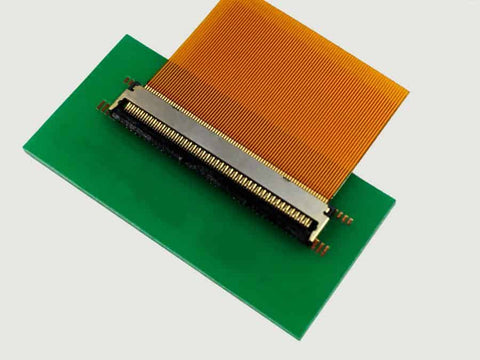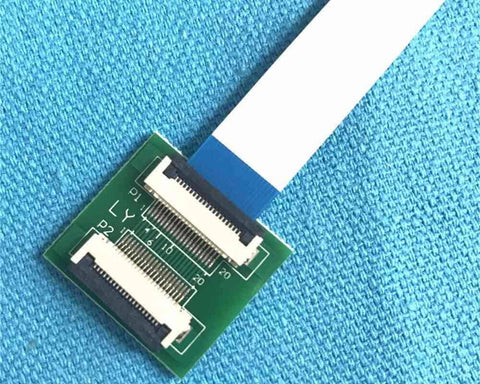FPC connectors have been established in response to challenges in this emerging industry which calls for smaller centerline or timer distances, smaller capacity heights, and lightweight interconnection solutions as the industry trends towards miniaturization. TE’s FPC connector is reliable interconnections using FPC cable terminators are field-specific terminable (no tools necessary), available in 0.25mm, 0.3mm, 0.5mm, 1.0mm, and 1.25mm interfaces, and low-profile detail height and compact characteristics.
Introduction
Connectors have been created to address the challenges of this expanding market, which requires smaller centerlines or pitch distances, lower profile heights, and lighter interconnect solutions. There are many ways to explore the capabilities of FPC connectors.
One of the prevalent cable connector alternatives for smart applications is a Flexible PCB connector(FPC). These connectors with fragile shape factors and unparalleled flexibility provide a very high density and therefore serve numerous advanced applications and in all different market segments. These flexible cable solutions can fit into tight rooms with a fantastic profile design with the constantly decreasing form factor criteria.
Request FPC Connector Quote Now
Where can FPC be used?
FPC connectors, such as wearable electronics and medical equipment, are widely used in many significant, convenient applications. In the automotive sector, increased FFC/FPC connectors support innovative capabilities like in-vehicle infotainment, bright lighting, driving autopilot modes such as ADAS, and support for navigation and safety settings.
With Smart manufacturing and 5G technology deployment, FFC/FPC connectors explore options in many next-generation applications. Amphenol provides high-performance, flexible, reliable FPC solutions to fulfil the requirements of all new devices.
The micro flex connectors provided in 1.00mm torque and 0.50mm torque are preferably used for a wide variety of automotive, medical, connectivity, data and commercial devices. ClincherTM and DuflexTM are ideal for industrial and modulation applications; in particular, shock or vibration is a problem, such as industrial control systems, non-automotive transport, and retail materials.
What is FFC Connector?

Flexible Flat Cable FFC connectors are ribbon-like plastic, polymer, film, or designed polyurethane connectors with metallic termination parallel to the foundation. On the other hand, FPC contains printed or inserted circuitry on the FPC cable board that helps the cable feature as a variable PCB. In 1.00mm and 0.50mm, pitch sizes, Amphenol offers multi-hight vibration-proof flex connectors. Both FFC/FPC connectors with a 2.49mm pitch are accessible in ZIP, Non-ZIF, LIF, and high-speed.
Where can FFC be used?
FFC (flexible flat cables) are a kind of ribbon cable called its comprehensive centralized system. Usually, they are smooth connectors without extra tools. FFC cables are generally a plastic film connected to several metallic connectors referred to as “pitch.”
The construction of FFC cables makes it less space and more flexible than round cables and often provides better EMI / RFI removal and the elimination of wire coupling problems.
They strive to be used in more excellent electronic systems — particularly where high levels of flexibility are required, such as connections to a moveable printer head, wrapping mobile phones, or mass or space restrictions.
Electronic equipment offers a selection of FFC cables for soldering or connecting with 0,5 mm, 0,8 mm, 1 mm, 1,25 mm, and 2.54 mm pitch.
Electronics provides a variety of FFC connectors satisfactory for different pitches to enhance our range of FFC cables.
Difference between FFC & FPC
Most users, mainly those new to the electronic and printed circuit boards world, can be tricky when distinguishing between FPC and FFC.
While FFC and FPC would be the same, they are entirely different. Look closely. They also offer various advanced features. Then how do you spot the difference between FFC/FPC connectors?
Here you will find how the difference between two cables can be understood;
Application Differences in FFC&FPC
There are several different roles of both the FFC and the FPC cables; FFC cables are used extensively for high-flex applications, starting with their specific applications. Everyones use widening in almost all electrical appliances we use in modern times. Plotters, copiers, scanners, fax machines, stereos, and LCD appliances are also used in the application areas of FFC cables.
FPC is available in antennas, audible devices, LCD TVs, cameras, laptops, and printers. They are also pervasive in the aviation sector. FPCs have developed over the years, offering performance and quality.
Production Difference in FFC FPC

FFC are also different from FPC when it comes to manufacturing processes. FPCs are produced by grafting on the Flexible Copper Clad Laminate (FCCL) and cut to size into various layers then. However, FFC requires a structured lamination of the copper wires and flat polyethene terephthalate (PET).
That’s why, we realize that cables are usually a little thicker and much more important than flexible printed cables. In contrast to FPCs, FFCs are made with two layers of wires that insulate the foil on its flat copper ductor.
The Thickness
As already mentioned, FFCs would work well in several application areas. Compared with flexible printed circuits. For example, tight fields require cables of a greater thickness than cables in applications that are not highly stressful.
The ideal thickness of FFC wires designed to work in challenging environments is 0.5mm, 0.8mm, 1.0mm,1.25mm, 1.27mm, 1.5mm, 2.0mm, and 2.54mm. On the other hand, there is little room for FPC cables, many of which are thick between 0.15 mm and 0.2 mm.
Inability to Replace Eachother
Finally, the inability to substitute or fit where others can work while working as required differentiates versatile circuits from flat flexible cables. For example, their manufacturing strategies are classified. Flexible printed circuits, in comparison with flexible flat cables, are somewhat vulnerable.
Nevertheless, flexible flat cables include components that are good heat highly conductive. As such, one could almost not fit into another’s role. Another significant element between FFCs and FPCs is, therefore, the inability to replace one another.
FPC connectors Types
There are many different FPC connector types in ideal applications, including FPC. The categories of products can be defined as internal FPC connectors.
- Pitch 0.2mm: Y2B series.
- 0.3mm pitch: Y3BL Series, Y3B/W Series.
- Pitch: 0.5mm: Y5B series.
Panel to Panel Connector
The Panel to panel connector trend for mobile devices is smaller than the pin width and length that the 0.4mm pitch is the primary item and will grow to 0.35mm or lower, followed by a lower height request and protecting in the coming years. At the same time, the BTB (Board to Bard connector) height will also decrease to 0.9mm.
FPC Battery Connector
The battery connector can be split up into the type of elastic sheet and knife. The battery connector technological trend is primarily miniaturization, new battery functionality, low contact properties, and excellent connectivity reliability.
Connector I/O
I/O Connector is among the essential interfaces on mobile telephones and other electrical systems, such as power and signal link, volume reduction, and product standardization. The connector must be slimmer, the visualization and the water-resistant function must be provided.
FFC/FPC connector Molex has a broad range of products that deliver the best variety of signal reliability, controllability, wide circuit size range, and cable style of any similar model on the market.
In contrast to flexible flat cables, there are several FPC connector types, as shown below.
- Single-layer circuits
Also referred to as one-sided circuits. These are made of rust polymer or metal only with a single conductive layer on flexible carbon nanotubes. These are cheap to produce compared with the rest.
- Two-sided
These are flexible circuits, as the name suggests. They are made up of two layers of drivers.
- Flexible multilayer circuits
Three or even more layers of transmission lines are available. Some of them have 4 layers. Others may have up to six layers, whereas others may have more than ten layers of drivers. Compared with single or double flex circuits, they are costly to produce. Multilayer flex circuits can also be available in a variety of sizes.
Important Parts of FPC Connector
The FPC connector is the latest kind, laminated by an elevated automatic processing equipment line of data cables made of PET isolation material and excellent tinned flat copper wire. To make the electrical and mechanical connections, it is used to relate the circuit board (PCB) and the flexible imported circuit board (FPC).
There are prescriptive matching specifications between FPC connector structures, and the accuracy of the three components in production is critical.
terminal
The terminal is the FPC/FFC connector contact part. The FPC/FFC connector terminal is used to ensure a high-density connector setting and stable contact performance by using a narrow contact method and selecting the material with high biocompatibility and mechanical properties.
Plastic body
Everything inside the plastic material is a sheet-like barrier framework, which can be organized after installation at a small interval and gives a specific stabilization force. According to the applicable specifications of the application, the plastic body must be strong and rigid enough, and no warp deflection must occur before and after the soldering of the SMT.
Card lock
The locking components are matched to the plastic body. The fastening parts are used to lock the FPC/FFC to preserve a specific contact force when the FPC/FFC is implanted. The parts must therefore be sufficiently rigid and are mainly prepared with raw PPS components.
Related Posts:
1.What is the difference between rigid-flex board assembly and multi-plate system assembly
2.The Difference Between Multiple FPC
